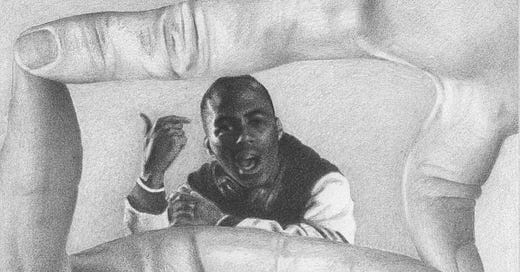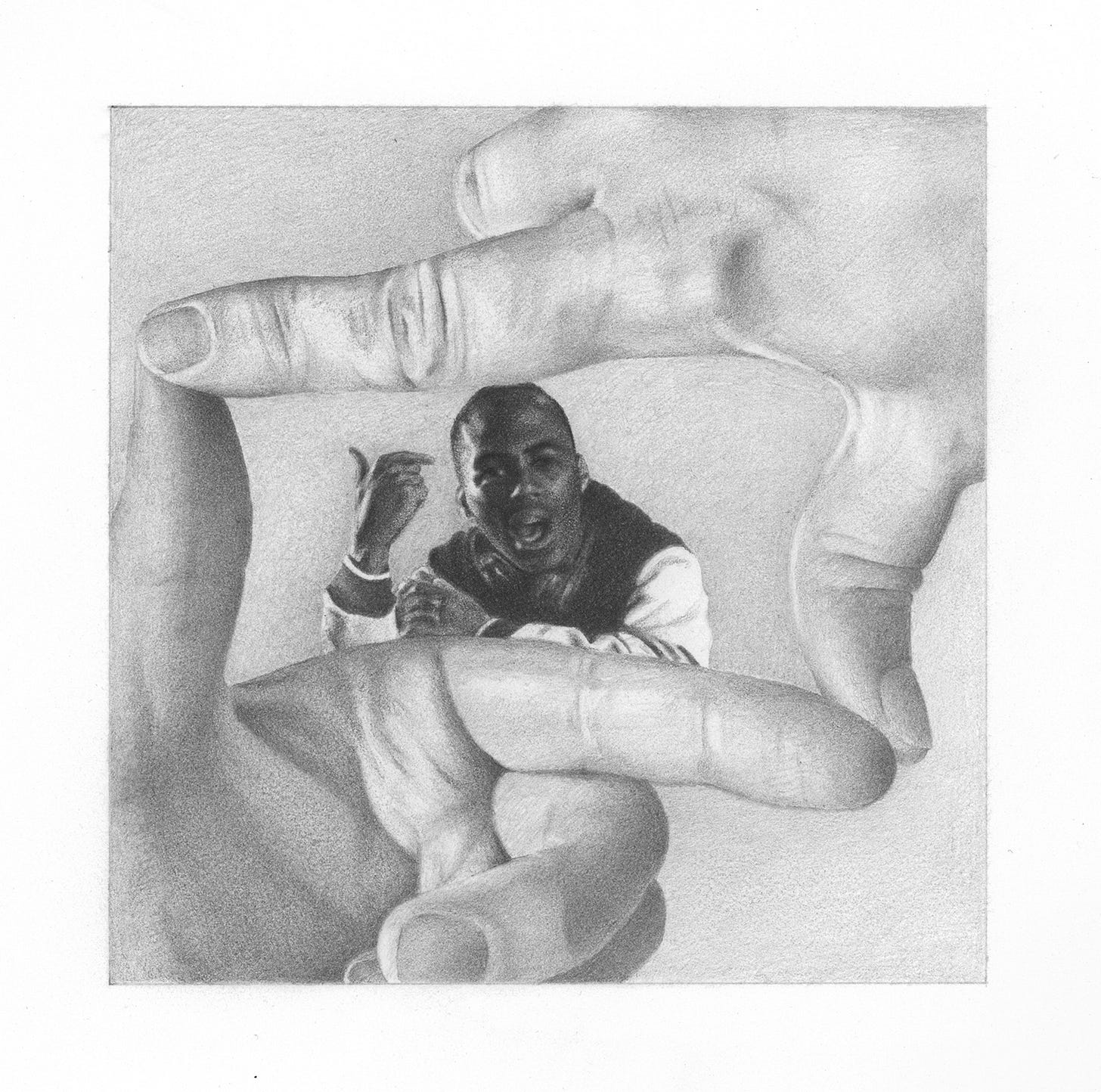This visual essay is a tribute to Coleman Hughes. It’s part of an ongoing series called Ideas Worth Drawing For, in which I make hand-drawn images to honor the excellence of essayists I admire.
What happens when we frame black Americans with white hands?
In “The Case for Back Optimism,”1 the writer
2 demonstrates how the framing effect shapes our perception of progress. He analyzes whether it is still true, almost a quarter of the way through the 21st century, that “America has defaulted on this promissory note insofar as her citizens of color are concerned” that “black men as well as white men, would be guaranteed the inalienable rights of life, liberty, and the pursuit of happiness,” as Rev. Martin Luther King Jr. put it in his treasured “I Have a Dream” speech. Hughes extrapolates opposite stories from the same data:All told, there is more than enough data with which to tell an optimistic story about the recent history of black America. However, the same data that justify this optimism can appear to justify pessimism if you look at it differently. Recall, for instance, the 72 percent drop in the incarceration rate for black men aged 18–19 from 2001 to 2017. Framed as such, it looks like progress. But here’s the same data framed differently: In 2001, black men aged 18–19 were nine times more likely to be behind bars than comparable white men. By 2017, they were twelve times more likely to be behind bars. Framed as such, it looks like regress.
This particular framing effect is just one example in a larger pattern: The evidence against racial progress tends to compare black-white gaps today to black-white gaps in the past. Here, white metrics are used as benchmarks against which to measure black progress. By contrast, the evidence in favor of progress tends to compare black metrics today against black metrics in the past. White metrics do not enter the equation. Crucially, the same data can often be made to look like either progress or regress depending on which framework is chosen.
So when we frame black Americans with white hands, we tell a pessimistic story of 21st century America that casts doubt on Rev. King's hopeful proclamation that the arc of the moral universe bends towards justice. Hughes characterizes this frame as treating “American society as if it were a simple 8th-grade science experiment: white people are treated as the ‘control group’; black people are treated as the ‘experimental group’…” But if we stop viewing white Americans as exemplar citizens, then Rev. King's dream solidifies into his legacy rather than his fantasy.
Hughes’s optimistic re-framing prods progressives and conservatives alike to feel uncomfortable with their respective party lines on race. As Hughes points out, “In an era when bipartisan agreement is scarce, the Left and the Right seem to be united in their somber assessment of black America, though they locate the blame in different places.” It seems odd for an uncomfortable truth to be so cheerful.
But I think the Left and Right can both be won over to Hughes’ optimistic re-framing. Maybe each set of partisans needs a spoonful of sugar to help the statistics go down – and scoring political points is high fructose corn syrup in a polarized society. This argument might taste sweet to progressives: “The Right loves telling black Americans to pull themselves up by their bootstraps, without realizing that they already have!” Conversely, conservatives could scoff, “The Left is so consumed by the soft bigotry of low expectations that they don’t even notice how well black Americans are doing!” Perhaps the sugar rush of an angrier re-re-framing of Hughes' optimism could invert this rare bipartisan agreement.
And a bipartisan consensus that embraces Hughes’s positive frame could reinforce and accelerate the reasons for optimism. Hughes argues that treating black Americans as a deviation from white Americans holds them back:
…a group of people can be doing quite well but can nevertheless be made to believe the opposite—so long as they are habitually compared to other groups in the media. It’s a truism that a single person suffers when he measures himself by the yardstick of another, particularly when the other person had various advantages and head starts that he lacked. In a similar way, by forever measuring blacks against an improper yardstick, the gap-lens, though intended as a way of acknowledging the unique history of oppression blacks have endured, in effect punishes them twice for it.
…
More importantly, if we want to continue making progress, then we must understand the root causes of progress, and in order to understand its root causes, we must first acknowledge that progress has happened. In recent decades, black Americans have been progressing, sometimes rapidly, along virtually every dimension worth caring about. And, without becoming complacent, we can be cautiously optimistic that such progress will continue. A complete conversation about race and racial inequality must involve not just identifying what goes wrong, but also what goes right—for if we fail to learn from the triumphs of our own recent past, we are doomed not to repeat them.
In his essay, Hughes is too polite to accuse anyone of racism for their pessimism, but readers can sense his frustration with pity for black Americans like himself. He rejects that pity as a Columbia graduate, a jazz trombonist who studied at Julliard, a published author, a writer so precocious that he was invited to testify before Congress in his early twenties opposite Ta-Nehisi Coates… and also as someone who can directly trace his lineage to slaves at Thomas Jefferson's Monticello plantation. Hughes makes a forceful case that a pessimistic frame helps no one aspire to greatness.3
I must admit that I often prefer pessimism. When things go badly, a pessimist can feel pleased with her prudence; when things go well, she can feel pleasantly surprised. Either way, she is content.4 But this pessimistic disposition is only healthy if she enjoys discovering that she was wrong, lest she develop a dogged longing for tragedy. Such pathological pessimism has the romantic allure of a Gothic poem.
Pessimism is a kind of darkness. By warning against it in “The Case for Black Optimism,” Hughes reminds us how Rev. King preached that “Darkness cannot drive out darkness; only light can do that.”
I encourage you to read Hughes’s piece in full at Quillette to take in the full breadth of evidence he summons for his argument. While you’re there, please take time to read my own Quillette essay “Experiments in Nurturing Classroom Curiosity.”
Coleman Hughes is the man pictured in the drawing above.
In an interview for
, “I Have a Dream” co-author Clarence Jones insists that black Americans have experienced significant progress and shares this message for young black Americans on this Martin Luther King Day:“Commit yourself irredeemably to the pursuit of personal excellence,” he says emphatically. “Be the very best that you can be. If you do that. . . our color becomes more relevant, because we demonstrate ‘black is beautiful’ not as some slogan, but black is beautiful because of its commitment to personal excellence, which has no color.”
Or in the words of my favorite pessimistic pundit Nick Catoggio, “One benefit of being a pessimist is that, when you’re forced to eat crow, it tastes delicious.”







Love this ♥️